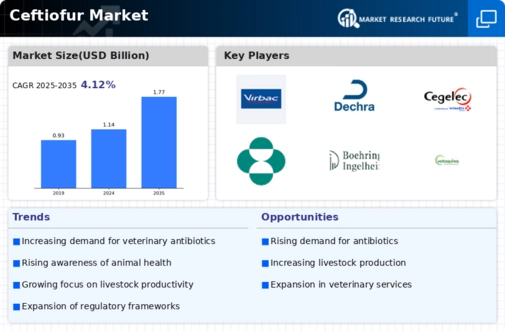Market Growth Projections
The Global Ceftiofur Market Industry is projected to experience substantial growth over the next decade. With an estimated market value of 1.14 USD Billion in 2024, the industry is on a trajectory to reach 1.77 USD Billion by 2035. This growth is underpinned by a compound annual growth rate of 4.06% from 2025 to 2035, indicating a robust demand for ceftiofur as a key veterinary antibiotic. Factors such as increasing livestock production, regulatory support, and advancements in veterinary medicine are likely to drive this upward trend. The market's expansion reflects the critical role of antibiotics in ensuring animal health and food safety.
Expansion of Livestock Production
The Global Ceftiofur Market Industry is significantly impacted by the expansion of livestock production, particularly in developing regions. As countries strive to enhance food security and meet the nutritional needs of growing populations, livestock farming is being prioritized. This expansion necessitates the use of effective antibiotics like ceftiofur to manage health issues and prevent disease outbreaks. The increasing scale of production facilities and the intensification of farming practices further drive the demand for veterinary pharmaceuticals. Consequently, the market is anticipated to grow, with projections indicating a rise to 1.14 USD Billion in 2024, reflecting the critical role of antibiotics in modern livestock management.
Increased Awareness of Animal Welfare
The Global Ceftiofur Market Industry is influenced by a growing awareness of animal welfare among consumers and producers alike. This heightened consciousness drives the demand for effective veterinary treatments, including ceftiofur, to ensure the health and well-being of livestock. As consumers increasingly prefer products sourced from healthy animals, producers are compelled to adopt practices that prioritize animal health. This trend is expected to contribute to a compound annual growth rate of 4.06% from 2025 to 2035, underscoring the importance of veterinary antibiotics in maintaining high standards of animal welfare and food quality.
Rising Demand for Veterinary Antibiotics
The Global Ceftiofur Market Industry is experiencing a surge in demand for veterinary antibiotics, driven by the increasing prevalence of bacterial infections in livestock. As animal husbandry practices evolve, the need for effective treatment options becomes paramount. Ceftiofur Market, a broad-spectrum cephalosporin antibiotic, is particularly favored for its efficacy in treating respiratory diseases in cattle and swine. The market is projected to reach 1.14 USD Billion in 2024, reflecting the growing reliance on such pharmaceuticals to ensure animal health and productivity. This trend is likely to continue as farmers seek to enhance livestock performance and meet the rising global food demand.
Regulatory Support for Animal Health Products
The Global Ceftiofur Market Industry benefits from supportive regulatory frameworks that facilitate the approval and use of veterinary medicines. Regulatory bodies, such as the U.S. Food and Drug Administration, have established guidelines that streamline the approval process for antibiotics like ceftiofur. This regulatory environment encourages innovation and the introduction of new formulations, thereby expanding the market. As a result, the industry is poised for growth, with projections indicating an increase to 1.77 USD Billion by 2035. Such supportive measures are crucial for maintaining animal health standards and ensuring food safety in the global supply chain.
Technological Advancements in Veterinary Medicine
The Global Ceftiofur Market Industry is benefiting from technological advancements in veterinary medicine, which enhance the efficacy and delivery of antibiotics. Innovations such as targeted drug delivery systems and improved formulations of ceftiofur are being developed to optimize treatment outcomes. These advancements not only improve the effectiveness of ceftiofur but also reduce the risk of antibiotic resistance, a growing concern in veterinary medicine. As the industry adapts to these technological changes, the market is expected to expand, with a projected growth to 1.77 USD Billion by 2035. Such developments are crucial for ensuring sustainable animal health practices.























Leave a Comment